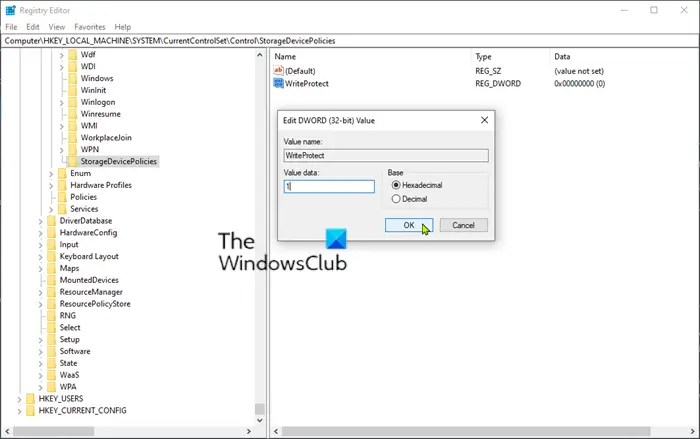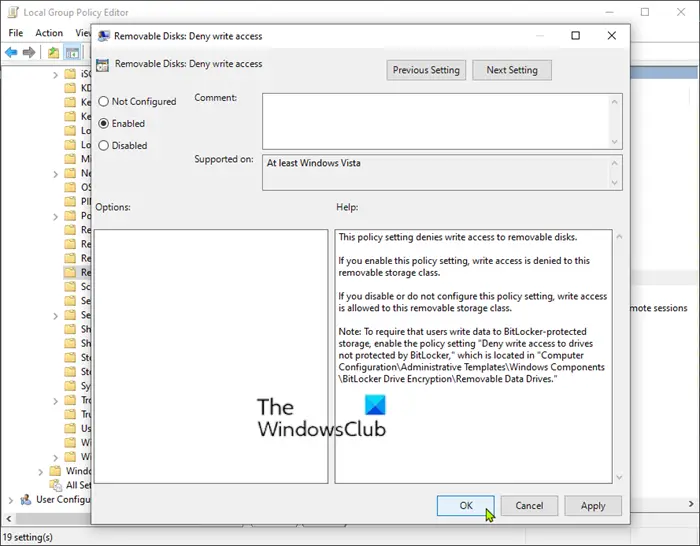USB Write access or USB Write protection is the security feature that can be enabled for any USB Data storage. The main purpose of enabling USB write access is to maintain the integrity of USB data storage. In this post, we will show you the ways you can enable or disable USB Write access on Windows 11/10.
By enabling Write protection, the data in the disk will not be modified. Thus it can prevent virus attack on USB Data storage or unauthorized file access/copy from Windows 11/10 OS to a USB drive by PC users.
There are two kinds of Write protection available for USB drives viz:
- Hardware Write Protection.
- Software Write Protection.
Hardware writes protection is mostly available in the card reader or floppy disks. In hardware write protection there will be a mechanical switch at the side of the card reader, in floppy, there will be a black slidable block in the lower-left corner. Once this switch is pulled over then the write protection is enabled. To turn off/disable just slide down the switch.
In this post, we will look at how to enable or disable USB Read or Write access using the software method.
Disable or enable USB Read/Write Protection on Windows
You can enable or disable USB Read/Write Protection on Windows 11/10 either of two ways via:
- Registry Editor
- Local Group Policy Editor
Let’s take a detailed look at the steps involved concerning each method.
1] Turn On or Off USB Write Protection via Registry Editor

This is a registry operation, so it is recommended that you back up the registry or create a system restore point in case the procedure goes wrong. Once you have taken the necessary precautionary measures, you can proceed as follows:
- Press Windows key + R to invoke the Run dialog.
- In the Run dialog box, type regedit and press Enter to open Registry Editor.
- Navigate or jump to the registry key path below:
HKEY_LOCAL_MACHINE\SYSTEM\CurrentControlSet\Control
- On the left pane, right-click on the Control key and choose New > Key and name it as StorageDevicePolicies and hit Enter.
- Now, click StorageDevicePolicies.
- On the right pane, right-click on a blank space and choose New > DWORD (32-bit) Value and name it as WriteProtect and hit Enter.
- Next, double-click on WriteProtect to edit its Properties.
- Input 1 in the Value data box and press Enter to save the change.
- Restart the PC for the changes to take effect.
That’s it. You have successfully enabled Write Protection for USB drives via registry editor.
If you wish to disable the Write Protection, open registry editor and navigate or jump to the location below.
HKEY_LOCAL_MACHINE\SYSTEM\CurrentControlSet\Control\StorageDevicePolicies
On the right pane, right-click the WriteProtect key and select Delete.
Restart the PC for changes to take effect.
Allow or Block Read Access to USB Drives via REGEDIT
Open Registry Editor and go to the following key:
Computer\HKEY_CURRENT_USER\Software\Policies\Microsoft\Windows
Create a new key under Windows, name the new key as RemovableStorageDevices and on the left side, name it as:
{53f5630d-b6bf-11d0-94f2-00a0c91efb8b}
Now, right-click on an empty area on the right side > select New > DWORD (32-bit) Value > Name it Deny_Read, and set its Value Data to 1.
Now when you connect a USB drive to your computer and try to open it, you will see error message – Location is not available. Access is denied.
Read: Can’t format USB Drive.
2] Enable or disable USB Write Protection via Local Group Policy Editor

To enable or disable USB Write Protection via Local Group Policy Editor, do the following:
- Press Windows key + R to invoke the Run dialog.
- In the Run dialog box type gpedit.msc and press Enter to open Group Policy Editor.
- Inside the Local Group Policy Editor, on the left pane navigate to the path below:
Computer Configuration > Administrative Templates > System > Removable Storage Access
- On the right pane, scroll and locate the Removable Disks: Deny Write access policy.
- Double-click on the policy to edit its properties.
- On the policy properties window, set the radio button to Enabled.
- Click Apply > OK to save the changes.
- You can now exit the Local Group Policy Editor.
- Next, press Windows key + R, type cmd and hit Enter to open Command Prompt.
- Input the command below and hit Enter.
gpupdate /force
Once the policy is updated, restart your computer for the changes to take effect.
Allow or Block Read Access to USB Drives via GPEDIT
In the Group Policy Editor, navigate to:
Computer Configuration > Administrative Templates > System > Removable Storage Access
Locate Removable Disks: Deny read access and set it to Enabled.
Remove: Media is Write Protected message.
That’s it. You have successfully enabled Read/Write Protection for USB drives via Local Group Policy Editor.
If you wish to disable the Write Protection, repeat the steps above, but for the policy, set the radio button to Disabled or Not Configured.
I hope you find this post useful!
TIP: USB Write Protect is a free tool that lets you enable or disable Write-protect USB with a click.
Leave a Reply